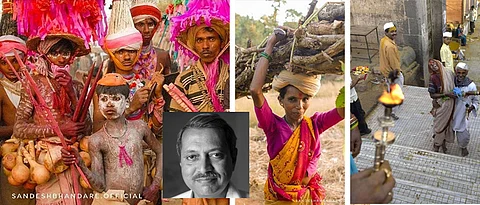

Often the subject of a frame can be the talking point, and it needn’t always be glamorous. Take a look at lensman Sandesh Bhandare’s arresting images of working men, women and children of Maharashtra and you will know why.
Primarily a still photographer, Bhandare has always been in the search of those faces who make the state what it is — hardworking, always on the move, and trying to find some joys in a weathered life. Maharashtra completed 60 years on May 1. Paying a tribute, Bhandare will be putting up 60 odd photographs of the common people on his Instagram @sandeshbhandare.official this entire month.
“Some of the photographs that have been uploaded on Instagram are a part of the series that were published in my book Asahi Ek Maharashtra and were also exhibited in different cities of the state. This book was published in 2010, to mark the golden jubilee year of the state. However, the work began early in 2003-04, with no intention that I would bring out a book or that they would be uploaded on social media,” he says.
In the early 2000s, Bhandare was working on documenting the lives of Tamasha artists, the art form, the taboos associated with it and so on. “I had finished working on the Tamasha project, and around that time I came across a copy of a magazine, Vaatsaru, edited by Abhay Kanta. For the cover of Vaatsaru, a friend of mine, Mehru Shaikh, gave a photograph — a man holding a flower on a street in Paris. It was a beautiful composition, but I found it incongruous on the cover of Vaatsaru, as the magazine highlighted the socio-political and economic conditions prevalent in Maharashtra. I thought it should have presented a slice of life of our society, by publishing photos of a bullock cart’s wheel, for instance, or men engaged in daily labour. For the next four years, I submitted black and white photos giving the readers a peek into our daily lives. There were photos of people, doors, a crack in the wall. All these images were conceptualised from the vision of a passer-by/traveller who was visiting our towns and villages and what s/he would see,” says Bhandare.
Through his work in the early 2000s and again in 2016-17-18, the Pune-based photographer wishes to acquaint us with the occupations and characteristics of our compatriots living in the countryside.
“I have always believed in documenting social realities. Photography usually spells glamour, but I wanted to train my lens on the ordinariness of the common man’s life — what are his sources of livelihood, how does he lead his life, his characteristics — children, women and men. I didn’t want the photographs to be in your face, but I subtly wanted to convey the importance of their work — ploughing the field, preparing the field, removing the weeds, controlling the forest fire.
I wanted to focus on their struggles, fight for survival, as they go about their lives. These are the people who support the economy, they are unsung, unseen and yet are an integral part of our lives. Down the line, if we want to know how our farmers and villagers led their lives, these photographs will serve as evidence, reference value,” he adds.
Bhandare’s two books, Tamasha — Ek Rangadi Gammat and Vari Ek Anandyatra are also a part of this larger project. He realised that he had documented the artform, but he had not done much to record the lives of the audience, the people who came to watch the performances.
“That was the time I clicked the picture of an old couple at Jejuri. His wife of many years was blushing when the man attempted to lift her in his arms, a ritual practised by newly-weds when they visit the temple. I happened to be there, when a newly married couple egged on the older couple to follow the ritual. I clicked this moment and it was of an unadulterated joy. Through this image, I wanted to highlight how simple actions can bring happiness. I want to capture all shades and emotions experienced by common people,” adds Bhandare.
The photographer shares another image of rural children studying diligently in a classroom, which has broken benches shoved in a corner and cracked floor tiles. “To my mind, this is an image that shows the villagers and the students trying to overcome all odds in their pursuit to get ahead in life,” he observes.
Bhandare also hopes to start a series on Vari in June, putting up his works from the annual pilgrimage that has people from all classes and communities walking to Pandharpur for a darshan of Lord Vithoba.
“I hope to upload some of the images from my book, Vari Ek Anandyatra. This year, I am not quite sure if the palkhis will travel to Pandharpur. This will be my way of bringing them in public consciousness,” he concludes.
